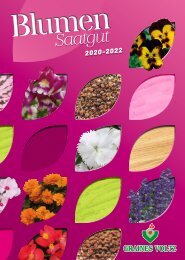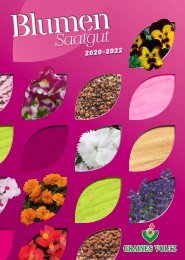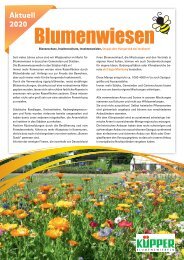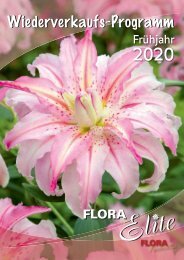Blumenzwiebelbuch Herbst 2017/2018 (englisch)
You also want an ePaper? Increase the reach of your titles
YUMPU automatically turns print PDFs into web optimized ePapers that Google loves.
Tulips<br />
Tulips | 21<br />
Delivery: End of August to end of November. | E = early, M = medium-early, L = late flowering<br />
Tulips originally come from the Middle East and<br />
arrived in Europe a few centuries ago through<br />
the Ottomans.<br />
The plant’s Latin name Tulipa comes from the<br />
Turkish word Tulbant or Tolibant.<br />
The first tulip bulbs were introduced in Europe<br />
from Turkey in 1554 and they attracted a lot of<br />
attention particularly in Holland. Over time, a<br />
boundless number of varieties were developed,<br />
with a large number that are still on the market<br />
today being created between 1950 and 1980, in<br />
particular. We have a broad colour range for tulips<br />
today, and the height and size of the flowers, as<br />
well as the time of flowering, vary greatly.<br />
Today, tulips are very popular spring flowers and,<br />
depending on the species and variety, are particularly<br />
suitable for cutting, for beds and borders, pots,<br />
rockeries and natural gardens.<br />
Tulips like a permeable soil that is not too<br />
heavy, and the location should be semi-shaded<br />
to sunny. They do not tolerate waterlogging.<br />
On graves and in beds, dark soils are often used,<br />
which because of their high black peat content<br />
have an acidic effect on tulips, leading to stunted<br />
growth. To prevent this, the soil should be<br />
enriched with calcium carbonate.<br />
where there are problems with voles, bulbs<br />
should be placed in baskets. Tulips should also be<br />
protected from hares and rabbits. In early spring,<br />
you can already use a complete fertilizer.<br />
Today’s overbred tulip varieties have a very<br />
short life and should be planted anew every<br />
year. (This is not true of a few wild tulips.) After<br />
flowering, the bulb, with leaves, should be<br />
completely removed to prevent diseases such as<br />
tulip fire from becoming established in the soil.<br />
Furthermore, you should not plant tulips in the<br />
same place year after year, as this can also lead<br />
to tulip fire. You should change the location every<br />
3 to 4 years.<br />
Propagation from seeds or offset bulblets is<br />
in theory possible, but is usually not worth it<br />
because tulips are firstly not open-pollinated, i.e.<br />
they segregate out, and secondly it takes around<br />
7 years for the first flowers.<br />
In the autumn, the bulbs are planted 10 to<br />
15 cm deep; improve heavy soils with sand and<br />
Follow the “scented”<br />
Following numerous requests, we have<br />
marked those varieties with a scent (balsamic,<br />
sweet, light and fruity or spicy-sweet) with<br />
the word “scented”.<br />
If you would like to know more about garden<br />
scents, we recommend Helga Urban’s book<br />
“Ein Garten der Düfte”, published by BLV<br />
Munich / ISBN 3-405-15406-5<br />
Please note:<br />
All the characteristics, cultivation descriptions,<br />
flowering times and heights<br />
of varieties and species provided in our<br />
catalogues and brochures are based on experiences<br />
from repeated plantings during the<br />
main cultivation period. Earlier or later planting<br />
out may produce different results, as can<br />
the effects of the weather, soil, location and<br />
different types of cultivation.

















